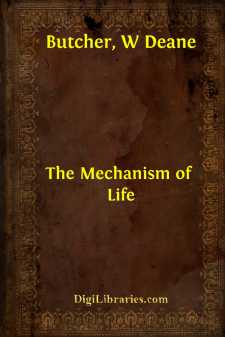Categories
- Antiques & Collectibles 13
- Architecture 36
- Art 48
- Bibles 22
- Biography & Autobiography 813
- Body, Mind & Spirit 142
- Business & Economics 28
- Children's Books 17
- Children's Fiction 14
- Computers 4
- Cooking 94
- Crafts & Hobbies 4
- Drama 346
- Education 46
- Family & Relationships 57
- Fiction 11829
- Games 19
- Gardening 17
- Health & Fitness 34
- History 1377
- House & Home 1
- Humor 147
- Juvenile Fiction 1873
- Juvenile Nonfiction 202
- Language Arts & Disciplines 88
- Law 16
- Literary Collections 686
- Literary Criticism 179
- Mathematics 13
- Medical 41
- Music 40
- Nature 179
- Non-Classifiable 1768
- Performing Arts 7
- Periodicals 1453
- Philosophy 64
- Photography 2
- Poetry 896
- Political Science 203
- Psychology 42
- Reference 154
- Religion 513
- Science 126
- Self-Help 84
- Social Science 81
- Sports & Recreation 34
- Study Aids 3
- Technology & Engineering 59
- Transportation 23
- Travel 463
- True Crime 29
The Mechanism of Life
by: W Deane Butcher
Description:
Excerpt
INTRODUCTION
Life was formerly regarded as a phenomenon entirely separated from the other phenomena of Nature, and even up to the present time Science has proved wholly unable to give a definition of Life; evolution, nutrition, sensibility, growth, organization, none of these, not even the faculty of reproduction, is the exclusive appanage of life.
Living things are made of the same chemical elements as minerals; a living being is the arena of the same physical forces as those which affect the inorganic world.
Life is difficult to define because it differs from one living being to another; the life of a man is not that of a polyp or of a plant, and if we find it impossible to discover the line which separates life from the other phenomena of Nature, it is in fact because no such line of demarcation exists—the passage from animate to inanimate is gradual and insensible. The step between a stalagmite and a polyp is less than that between a polyp and a man, and even the trained biologist is often at a loss to determine whether a given borderland form is the result of life, or of the inanimate forces of the mineral world.
A living being is a transformer of matter and energy—both matter and energy being uncreateable and indestructible, i.e. invariable in quantity. A living being is only a current of matter and of energy, both of which change from moment to moment while passing through the organism.
That which constitutes a living being is its form; for a living thing is born, develops, and dies with the form and structure of its organism. This ephemeral nature of the living being, which perishes with the destruction of its form, is in marked contrast to the perennial character of the matter and the energy which circulate within it.
The elementary phenomenon of life is the contact between an alimentary liquid and a cell. For the essential phenomenon of life is nutrition, and in order to be assimilated all the elements of an organism must be brought into a state of solution. Hence the study of life may be best begun by the study of those physico-chemical phenomena which result from the contact of two different liquids. Biology is thus but a branch of the physico-chemistry of liquids; it includes the study of electrolytic and colloidal solutions, and of the molecular forces brought into play by solution, osmosis, diffusion, cohesion, and crystallization.
In this volume I have endeavoured to give as much of the science of energetics as can be treated without the use of mathematical formulæ; the conception of entropy and Carnot's law of thermodynamics are also discussed.
The phenomena of catalysis and of diastatic fermentation have for the first time been brought under the general laws of energetics. This I have done by showing that catalysis is only one instance of the general law of the transformation of potential into kinetic energy, viz. by the intervention of a foreign exciting and stimulating energy which may be infinitely smaller than the energy it transforms....


